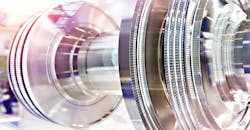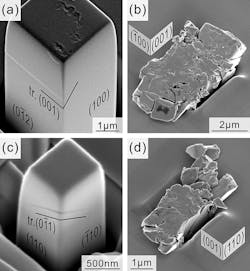Stressing Out About Heat Tolerance
The widespread initiative to reduce carbon-dioxide emissions continues to drive efforts to improve the thermal efficiency combustion systems, including those used in power generation and transportation. That of course means improving the thermal efficiency of gas-turbine systems used in power plants and jet engines, which in turn will demand further increases in the turbine inlet temperature (higher than 1,600°C.) Going further, achieving this will require developing structural materials that can perform at such high temperatures, because the temperature necessary to achieve that endurance is above the upper limit (around 1,400°C) of Ni-based superalloys currently used in the hottest sections of gas turbines.
Metals containing niobium silicide are promising in this application, because they can withstand high temperatures and improve efficiency of gas turbines in power plants and aircraft. But these materials’ complex crystal structures have made it difficult to accurately determine their mechanical properties.
Materials scientists at Japan’s Kyoto University researched and tested what happens at the micro-level when pressure is applied to tiny samples of these materials. They measured the plastic deformation resulting when a small probe exerted force on micropillar specimens (so-called, “micropillar compression”) of niobium silicide-containing alloys, with various loading axis orientations.
The researchers published their work in Science and Technology of Advanced Materials, offering insight that could help other materials scientists and metallurgists understand the atomic-level behavior of complex crystals, as they develop more heat-tolerant components in gas turbines.
“Our results demonstrate the cutting edge of research into plastic deformation behavior in crystalline materials,” according to Kyosuke Kishida, one of the four authors.Plastic deformation describes the atomic-level distortion that occurs when a sustained force is applied to a crystal. It is difficult to measure in complex crystals, but the Kyoto University team took a new approach to measure plastic deformation systematically in crystals that hold potential for use in high-temperature gas turbines.
They measured plastic deformation in α-Nb5Si3, a niobium-silicide alloy. Using a device with a flat-punch indenter at its end, ‘micropillars’ of such crystals were exposed to small amounts of stress. Stress was applied to different faces of a sample to determine where and how plastic deformation occurs within the crystal. Using scanning electron microscopy on the samples before and after the test, they identified the planes and directions in which deformation occurred.Following this, simulation studies based on theoretical calculations projected how the stresses affected the deformation at the samples’ atomic level.
Finally, the researchers compared the results with those of a boron-containing molybdenum-silicide alloy (Mo5SiB2) they had previously examined. “We found that instantaneous failure occurs rather easily in α-Nb5Si3, which is in marked contrast to Mo5SiB2,” Kishida explained.
Could this mean that the niobium-based alloy (α-Nb5Si3) would be less effective at enhancing gas turbine materials than the molybdenum-based option (Mo5SiB2)? Possibly yes, but according to the researchers other additives may yet provide the desired strengthening qualities to improve metals’ heat-resistance, and they plan to continue studying the mechanical properties of crystalline materials with complex structures to address their potential for that goal.


